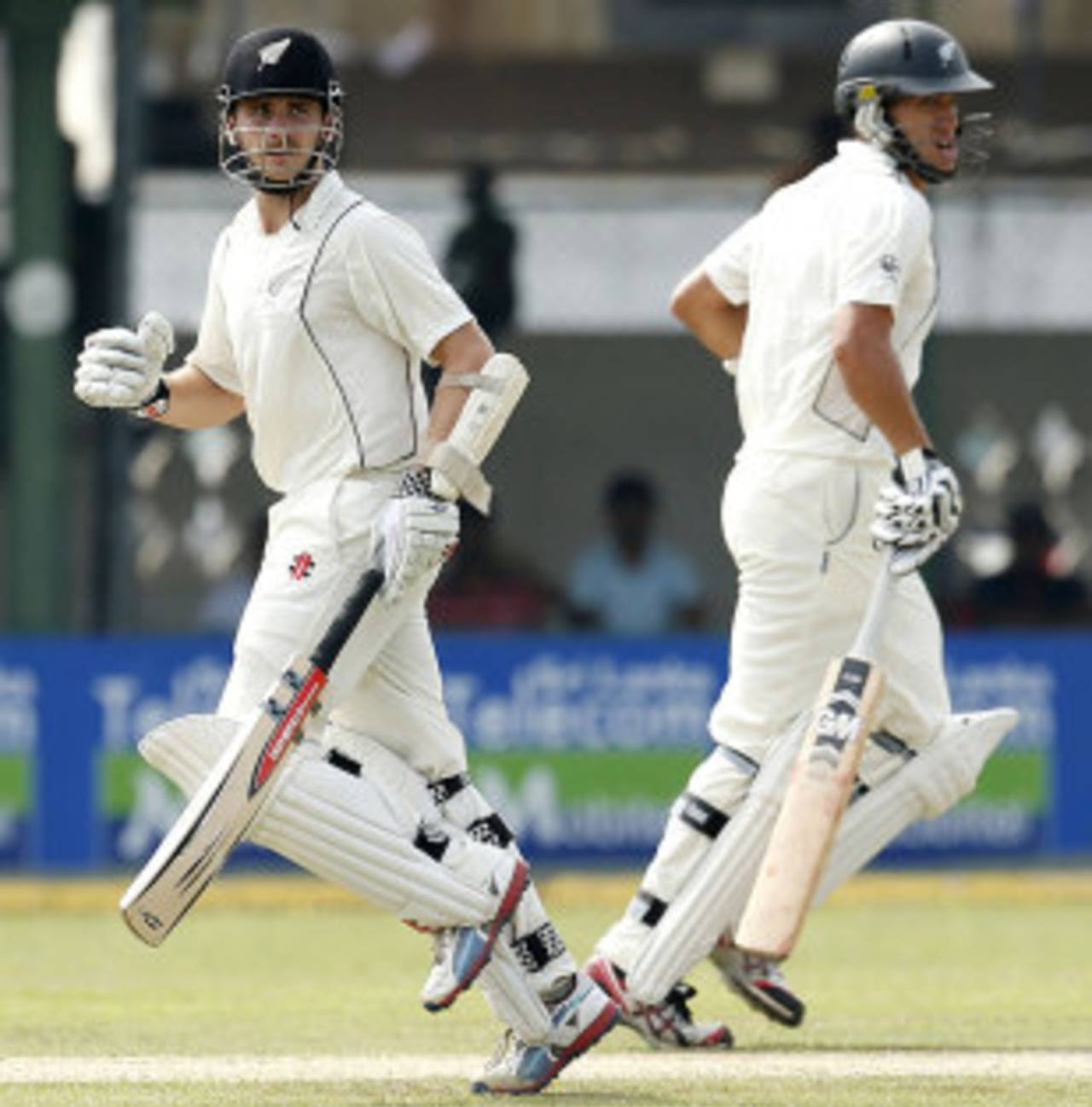Taylor and Williamson show New Zealand the way
On the opening day of the Colombo Test, Ross Taylor and Kane Williamson struck up exactly the right tempo for New Zealand, and worked the bowlers and the field like they had been in form for weeks
Andrew Fernando at the P Sara
25-Nov-2012

The temperament of Ross Taylor's partnership with Kane Williamson was a different universe from New Zealand's incompetence in Galle • Associated Press
When Sojourner Truth said the "night was often darkest before the dawn", New Zealand's Test travails were not the subject of her commentary. But on the first day of the second Test, the endeavours of Ross Taylor and Kane Williamson appeared to give sporting credence to her words, though they have much left to achieve yet.
Five days ago in Galle, New Zealand's batsmen played Rangana Herath like he was bowling grenades at them while they were being waterboarded. Seemingly clueless on how to defuse good spin bowling, the visitors poked, parried and stumbled their way to their lowest Test score in an already distressing year. At the P Sara, suddenly they were transformed. When the evening rains arrived to force an early close of play, Williamson and Taylor were batting on what is by far New Zealand's biggest partnership this year, and their best stand against a top-eight side since March 2009.
What was most striking about New Zealand was the sudden swell of steel in their demeanour. At the toss, Ross Taylor said his side needed "to show the public that we can fight", and his decision to bat first after their woes in Galle suggested he intended to walk the talk. It would have been easy for him to leave that mountain for another day. It had rained overnight and the P Sara pitch has historically been good for fast bowling, and though some would have questioned his judgement if he had opted to bowl first, that decision would be far from unjustifiable. Moreover, New Zealand's opening bowlers had built into some fearsome form through the limited-overs series, and were perhaps only one wicket away on the second morning from changing the outcome of the first Test. Still, Taylor chose instead to lay the gauntlet down for his batsmen. It was a track full of runs, and through his decision, he implored the batsmen to pull their weight.
New Zealand's desperation was also manifested in Brendon McCullum's ire at being wrongly given out lbw. In Galle's second innings, he punched his bat on his exit out of frustration for having played an unnecessary shot, but in Colombo his mood was closer to fury. He had been playing tightly, and when the umpire raised his finger, he scowled at the official, and cursed and spat his way to the dressing room, where his wrath probably took an even more palpable turn.
It is often said of batsmen who defy difficult conditions that they appeared to be playing on a different pitch from their peers, but the temperament and tone of Taylor's partnership with Williamson was New Zealand batting from a different universe from their incompetence in Galle. There, New Zealand had spoken of being positive, yet batted so dourly in some parts that Sri Lanka were not under any pressure in the field, and attacked so unwisely in others that they gifted away their wicket. Yet somehow in Colombo, Taylor and Williamson struck up exactly the right tempo, one which New Zealand should not stray far from, and worked the bowlers and the field like they had been in form for weeks.
Taylor should perhaps be especially pleased with his day's work, having played perhaps his most mature innings to date. When he reached triple figures off a respectable 189 deliveries, he had only hit eight boundaries in his innings - the fewest he had hit in any innings in which he had made a hundred. His wagon wheel shows only one boundary to midwicket, and even that was on on-drive on which he rolled his wrists. His favourite slog sweep, along with most of the power-strokes that characterise his batting, were shelved during this innings, and singles and twos were preferred instead. He had spoken of being positive against spin bowling ahead of the series - a feat he achieved today, yet he hit no fours off the spinners, not even off the part-timer Tillakaratne Dilshan. It is a statistic that betrays the will of a man who wishes to make a break from the bleak past.
Williamson's natural game is more adapted to handling spin, and perhaps his calm presence at the other end helped Taylor stave away the hankerings to hit out. Off the back foot, Williamson was impeccable, allowing him to pinpoint gaps almost casually despite Mahela Jayawardene's persistence with aggressive fields throughout the day. Unlike Taylor, who had to battle through a nervy period at the start of his innings, Williamson's knock was almost chanceless. He picked the lengths early and used his feet effectively to blunt the spinners. His steady hand and a technique built around defence is often a refreshing change in a side in which those qualities seem undervalued, but today, Taylor chose Williamson's approach and their partnership flourished as a result.
New Zealand are still a long way from avoiding a record sixth consecutive loss, and they will know all their success today came on a pitch that gave very little to bowlers of every ilk. It is not only a batting performance that must be extended on day two, it is one that must be emulated in the months to come, if New Zealand are to scramble out of their rut. But Taylor and Williamson have given the visitors a better start to the second Test than anyone would have imagined in the days leading up to the Test, and perhaps the side has left rock bottom behind.
Andrew Fernando is ESPNcricinfo's Sri Lanka correspondent